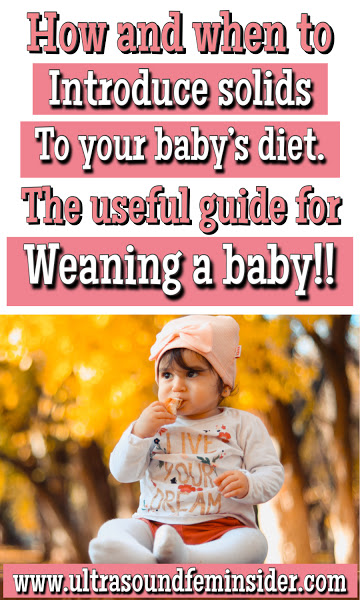When to wean is a question facing all breastfeeding mums. How does a new mum know when to introduce solid food into her baby’s diet, and what sort of food can a baby eat? Therefore in this post, we will talk about everything you need to know about weaning a breastfed baby.
At present, the World Health Organization recommends that all babies be breastfed exclusively for six months. A long time, you may think, especially in the middle of a colic episode or growth spurt! However, there are real concerns for the welfare of babies that have led to this advice.
In the past, many babies were fed solid foods at very young ages. It is now believed that their bodies were unable to cope with the demands this placed on them; a dramatic increase in the incidence of allergies and food intolerances meant guidelines were reviewed and altered. The main danger that comes with introducing solid food too early is that babies may receive too much salt in their diets, leading to potential kidney problems in later life.
So, if you follow the World Health Organization’s advice, you will see that it makes sense to put off giving food other than breastmilk for the first six months.
How to introduce solids to your baby?
So how do you encourage a six-month-old baby to eat solids? The main thing to remember is that you should introduce solids gradually.
When your baby is ready for solid food, he will begin to demand feeds more often and may never seem satisfied for very long. He will start to take an interest in your meals and may even try to help himself! He will begin lip-smacking and chewing as he mimics you. A real sign that solids are imminent is the development of teeth.
Always consult the pediatric doctor first if you have questions about Weaning a Breastfed Baby.
Speak to the doctor if you think your baby is very hungry. If your baby is under six months, you may find that he is just going through a prolonged growth spurt. If this is the case, his hunger will typically settle down after a few days when your milk supply has increased.
When and how to introduce solid food to a baby?
- When your baby reaches the six-month target, and you are sure that he is ready for solid food, try a teaspoonful of watery baby rice or baby porridge. Try to keep foods very bland and runny at the beginning.
- Once he is used to solid foods and is no younger than six months, you can quickly move onto adult cereals like Weetabix and Readybrek.
- It is wise only to introduce one food at a time so that you can identify any intolerances or allergies. Sometimes these can take several days to take effect, so stick to one food for a few days before moving onto another.
- Some babies are happy to have one solid feed a day at the beginning of weaning, whereas others require more frequent meals. It is an excellent idea to offer the breast before and after each feed to maintain a good milk supply.
What foods are appropriate for a Baby, and what foods to avoid?
- Cows milk and dairy products, eggs, fish particularly shellfish), nuts (especially peanuts), some fruits, and foods containing gluten can all cause allergic reactions. So be careful with your choice.
- From six months, babies can digest protein. Therefore, red meat, fish , eggs, cheese, chicken, and pulses can be introduced.
Do not give peanuts to babies under one year old: if there is a history of allergies in your family, avoid giving them for at least three years. As well a being an allergy hazard, they can also be a choking hazard.
- Honey should also be avoided for the first year as babies can contract botulism from it.
- Eggs must be thoroughly cooked and can be introduced after six months of age.
- Buy gluten-free baby food at the beginning of weaning, if possible, as gluten can cause celiac disease. Usually, a six-month-old baby can digest gluten without any problems, but younger babies are more at risk.
- Some babies react to citrus fruits such as oranges, but alternative fruit juices can be given instead, such as apple juice.
Never add salt to food which your baby will eat. If he is ready to eat the same meals as the rest of the family, do not add gravy until you have removed the baby’s portion, as gravy can contain a lot of salt.
- It is best to introduce savory foods prior to sweet foods as babies quickly develop a sweet tooth! They tend to enjoy puree of carrots, broccoli, sweet potatoes, turnip and parsnip, and any combination of these foods. Babies also love stewed apples and pears or mashed bananas and strawberries!
However, many babies dislike potatoes at the beginning of weaning. When the baby is a little more experienced with tastes and textures, you can start adding some potatoes to his meals.
To check out our YouTube channel, click this link.
What you should keep in mind during the process of Weaning A Breastfed Baby.
Let the baby decide when he has had enough of any particular meal. Never force-feed the baby. He only needs a little bit of solid food each day. For some babies, a few spoonful will be enough; for others, a main course and dessert are required! If he refuses to eat one type of food, avoid it for a while and try something else. Return to the disliked food after a few days and try again. Some babies can be very fussy, whereas others eat whatever is placed in front of them!
Related posts you might find helpful and interesting.
5 essential tips to take care of a newborn baby.
11 excellent tips for traveling with a baby.
Ultimate guide to baby-proofing your home.
Tips to help your colicky baby to get relief.
Final thoughts about Weaning A Breastfed Baby.
Take it slowly, and it will not be such a significant change for either you or your baby. Weaning should be a fun experience for you both. After a very short time, your baby will look forward to his solid feeds and will even start to let you know that he wants more!
I hope this article was helpful to you. If you enjoy it, share it with other mommies.
Zadi, xo.











To wane are not to wane is definitely the million dollar question and you aptly took it on with your tremendous observations and extensive knowledge my friend, you said some very important things to consider, like: always consulting a pediatric doctor, avoid adding salt and even sugar and spices etc; being very careful with the kind of fruits and nuts etc that you give them, and also paying close attention to their reaction to the food and to the effects the foods may be having. It’s one thing to feed the baby but another when it becomes force-feeding the baby. You have said so many great things and your post is packed full of extremely helpful details that my short comment does not even address but I have learned so much and I am glad I came by as always haha.
I am so glad to know that you learn and enjoy so much my post. Weaning a baby appears simple, but is a complicated process, in which parents needs to pay close attention to reactions, and be extremely patient with the changes of routine, for some babies those changes are not well received.
Absolutely Zadi <3 <3. Yes you are definitely right. Waning a baby is certainly a learning process especially since they can not articulate themselves to let you know exactly what is on their mind which means you have to be patient and really observe their moods and behavior, and this could take a while just like you said lol. And I also apologize for the late response my frend.
Thanks
awww anytime Zadi, you’re welcome <3
[…] The guide for Weaning a Breastfed Baby. […]
[…] The guide for Weaning a Breastfed Baby. […]